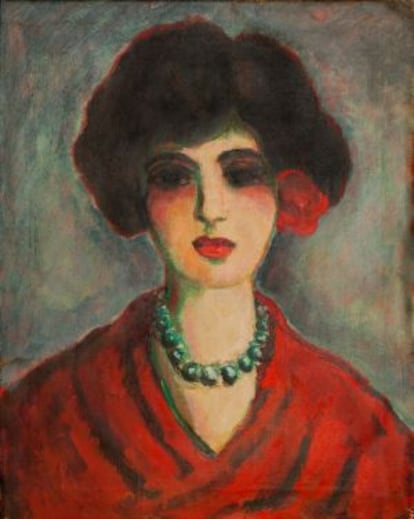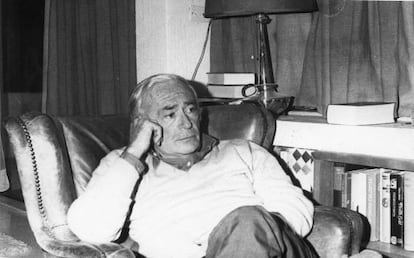A feast of fake masterpieces
Madrid's Círculo de Bellas Artes is showcasing work by Hungarian genius Elmyr de Hory The art forger painted Picassos, Monets, Matisses and Modiglianis


If legend has it right, the best works by Elmyr de Hory are not included in the exhibition that opened this week at Madrid's Círculo de Bellas Artes; instead, they are to be found in the world's major art collections and museums, masking as genuine works by the likes of Picasso, Matisse, Monet, Degas, Van Dongen and Modigliani.
Elmyr de Hory. Proyecto Fake offers a unique insight into one of the most entertaining, reckless and ultimately tragic figures in art history through nearly 30 works that the master forger made "in the style of" somebody else. It is the fascinating story of a Hungarian-born rogue who pulled the wool over the art market's eyes with the skill of an old sea dog.
In a country lately defined by endless cases of fraud, this tribute to one of the greatest fraudsters of all time could not come at a better moment. His histrionic, eccentric, glamorous persona was definitively sealed in the early 1970s thanks to Orson Welles' famous documentary F for Fake, in which the filmmaker showcased the character's radical discourse against the established order. Welles took the side of De Hory, assuming his own role as an enormous charlatan in a world of fake truths.
In a 1973 interview, the maker of fakes portrayed himself as a victim rather than a forger. "I dislike the word, and besides, I don't find it fair. I am a victim of the customs and laws of the world of painting. Is not the market itself the real scandal? On a merely artistic level, I would like to consider myself a performer. Just like one can love Bach through Óistraj, one can love Modigliani through me."

"Faced with such an invasion of conservative exhibitions with historic but no artistic value, the questions asked here could not be more opportune," says Juan Barja, director of the Círculo de Bellas Artes. "These days people don't go to see an artwork because of its value, but because they're told it's by X or Y. That's not culture. This exhibition is like a healthy dose of vinegar for our salad."
The story of Elmyr de Hory is one of large-scale personal revenge. It is the mockery that a remarkably gifted painter makes of the critics who kept him out of the system. "He achieved his goal, to be recognized as an artist," says Dolores Durán, the show curator. "These days, there are so many fake Elmyrs around that it's hard to find a real one." An authentic Elmyr fake now commands up to 100,000 euros.
Today people don't go to see an artwork due to its value, but because it's by X or Y"
The scandal (and the legend) was uncovered in 1967, when the oil tycoon Algur Hurtle Meadows, founder of the Virginia Meadows Museum in Dallas, began suspecting that something was wrong with his magnificent art collection. Two years later, a writer named Clifford Irving published Fake! The Story of Elmyr de Hory, the Greatest Art Forger of Our Time, a book that reconstructed the forger's life. But to make things even more complicated, Irving himself landed in jail a few years later for writing a phony autobiography of the eccentric millionaire Howard Hughes.
"Irving played an essential role in the making of this exhibition," explains Durán. "He's the one who put us on the trail of the paintings." Asked for clues to Irving's present whereabouts, Durán said mysteriously: "Right now he is lying in the sun on some Mexican beach."

There is no doubt that the sun is a key element in this story. When Elmyr ended up in Ibiza in the 1960s, stripped of his passport (he entered Spain under a fake identity, Joseph Boutin) and wanted by the law, he decided to settle down. He lived on the island for 15 years, bent on defending his questionable innocence and convinced that he had found his place in the world. His friends (who included celebrities such as actress and Bond girl Ursula Andress) adored him, and when news of his suicide broke in December 1976, they pointed their fingers at his lover, Mark Forgy, whom Elmyr had made his heir only one week earlier.
"Before dying, Elmyr had tried to commit suicide not once, but up to five times," says Durán. It was his way of avoiding the permanent threat of extradition. He swallowed large amounts of sleeping pills and was always rescued from the brink of death by a friend. But Forgy was late, and the shadow of suspicion was cast over him. The extradition order arrived the next day.
Ibiza's white cemetery holds the remains of one of the art world's greatest forgers. Where all his fakes have gone to remains a mystery, but his triumph over adversity is by now crystal clear.
More copies than thefts
There are art robbers of all types: intelligent, clumsy, violent... There is no common denominator for this type of criminal. Yet all forgers, or at least the good ones, share a similar profile: they can paint, they are artists.
"There are nearly as many forgeries as authentic paintings out there," states a police expert, perhaps a little hyperbolically. Or maybe not: Spanish police seize around 100 art forgeries every year.
There is a joke in the art world that the 19th-century artist Jean-Baptiste Corot made 10,000 paintings, 25,000 of which are in the United States. The point is that the French painter's landscapes became so popular that forging them became a small industry in itself.
Experts agree there is an enormous black hole of art forgeries that is impossible to put a number on. Buyers often know it, among other things because the price they pay is notably below what an original would fetch, and they willingly accept the deal. This way, they can boast about having a Goya or a Dalí hanging at home.
History has produced master forgers such as the Hungarian Elmyr de Hory, the Dutchman Han van Meegeren (specialized in imitating Johannes Vermeer) and the Briton Tom Keating, who was able to perfectly imitate the work of Degas, Constable and Samuel Palmer, among other painters.
On more than one occasion, the forgers are people who are close to the artist - their secretaries or art dealers, often. It happened with Salvador Dalí and with José Vela Zanetti, whose most famous imitator hung himself in his own home in 2008.
So what is being forged the most these days? The work of old masters such as Picasso, Marc Chagall, Kandinsky and Van Gogh.
Tu suscripción se está usando en otro dispositivo
¿Quieres añadir otro usuario a tu suscripción?
Si continúas leyendo en este dispositivo, no se podrá leer en el otro.
FlechaTu suscripción se está usando en otro dispositivo y solo puedes acceder a EL PAÍS desde un dispositivo a la vez.
Si quieres compartir tu cuenta, cambia tu suscripción a la modalidad Premium, así podrás añadir otro usuario. Cada uno accederá con su propia cuenta de email, lo que os permitirá personalizar vuestra experiencia en EL PAÍS.
¿Tienes una suscripción de empresa? Accede aquí para contratar más cuentas.
En el caso de no saber quién está usando tu cuenta, te recomendamos cambiar tu contraseña aquí.
Si decides continuar compartiendo tu cuenta, este mensaje se mostrará en tu dispositivo y en el de la otra persona que está usando tu cuenta de forma indefinida, afectando a tu experiencia de lectura. Puedes consultar aquí los términos y condiciones de la suscripción digital.
Últimas noticias
Most viewed
- Reinhard Genzel, Nobel laureate in physics: ‘One-minute videos will never give you the truth’
- Pablo Escobar’s hippos: A serious environmental problem, 40 years on
- Charles Dubouloz, mountaineering star, retires at 36 with a farewell tour inspired by Walter Bonatti
- Why we lost the habit of sleeping in two segments and how that changed our sense of time
- The Florida Keys tourist paradise is besieged by immigration agents: ‘We’ve never seen anything like this’








































